
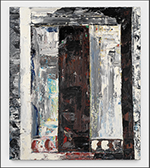
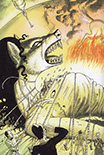
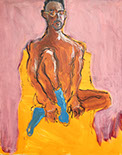

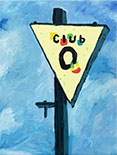

Antonia Kuo & Pauline Shaw
Chapter NY
by Paul Moreno
Chapter NY’s recent two-artist exhibition of works by Antonia Kuo and Pauline Shaw was immediately engaging upon entering the gallery. As I walked through the show, the work became more and more captivating. The two artists were each represented by two distinct aspects of their practices. This was a smart curatorial decision. It presented the viewer with four very different types of objects that together filled the gallery space beautifully and inspired the viewer to make visual, material, and thematic connections.
Pauline Shaw provided the most representational work in the form of two sculptures evocative of old-timey street lamps in their shape but more human-sized in height. The two works, Streetlight (2022) and Nightlight (2022) were fraternal twins. Identical in size, each came with nearly identical cast bronze posts that touched the ground an impossibly delicate amount, and each balanced a strange but unique glass head. In one, the globe atop the sculpture contained a miniature bed that was quite simple in design, a Parsons desk of a bed. The bed sat on a glass floor, and its legs connected to a second tiny bed hanging inverted on the opposite side of the floor. This second bed was a more elaborately carved four-poster. These tiny beds, complete with linens, were connected by a serpentine chain with a large unique object at each end. In the globe of the other light post, the glass floor was scattered with glass marbles, the kind that kids might have played with in olden days. Below the marbles, small stalactites hung into the hemisphere below, suggesting that if you could break those stalactites open, the marbles’ twins might be found. Upon further looking, one might have realized that the lamp posts were themselves cast from bed posts. They had beautiful gunmetal finishes and were ever so lightly engraved. The sculpture with the beds was engraved with a botanic motif, and the other depicted something skeletal, somewhat dragon-like, that winds around the post, never letting the viewer see it all at once.
Four felted wool works, also by Pauline Shaw, were hung throughout the space, two of them on the wall. Knight Knight (2022) at nearly eight feet tall and five feet wide, was hung away from the wall so that the viewer could walk around it. The face of the work was astoundingly complex, evocative of Persian rugs, Venetian paper, Rorschach tests, and the wax lozenge sculptures of Lynda Benglis. The colorful abstraction included but was not limited to indigo, salmon, champagne, rust, and celadon—all rich with the undulations and saturation of plush wool. Flowers and birds appeared here and there. I overheard other folks describe the work as “evocative of down there” and also “like a praying mantis.” Looking closely, one finds that, over this entire colorful field, a skeleton of a figure floats on top, drawn in embroidery, connecting the textile work to the streetlight sculpture.
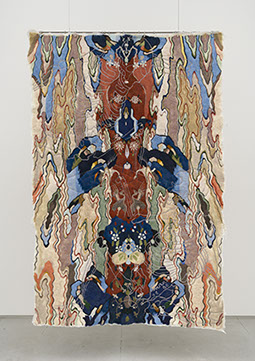
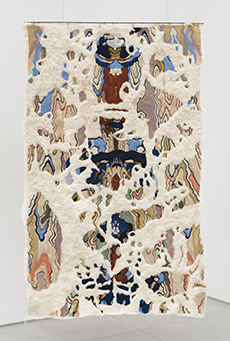
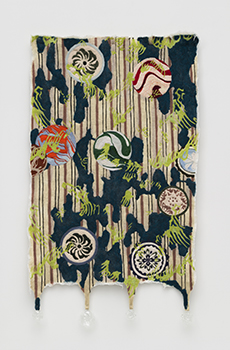
Pauline Shaw (Left), Knight Knight, 2022. Felted wool and silk, cotton scrim suspended through cable wire, steel rod, stainless steel hardware, 93 x 60 x ¼ inches. (Center) Death Rattle, 2022. Felted wool and cotton scrim suspended through cable wire, steel rod, stainless steel hardware. 97 x 60 x ¼ inches. Taw, 2022. Felted wool, cotton scrim, glass, 69 ½ x 40 x 2 ½ inches. Photos: Chapter NY.
Another fabric piece, Death Rattle (2022) was similar to Knight Knight. However, this piece replaces the subtly rendered skeleton on the colorful carpet of Knight Knight with what looks like a huge splatter or spill of white wooliness. But it is not a spill; rather, it is an application of felted wool acting as an abstract, if not non-objective, gesture of painting without paint. There is something profound in this act. Instead of the explosive and easy mark-making of throwing paint, out of a can, onto a canvas, the artist has relied on a slow and deliberate and repetitive act of building up a pillowy compositional element that has the feel of spontaneity but the control of a true craftsperson. It is akin to discovering that a circle of mushrooms has appeared on the lawn overnight. You know it is not magic; but the prettiness, the knowledge of all the time that went into creating this instant, the allure that makes you want to touch mixed with the respect that only permits your gaze—all feed a sense a wonder.
There is an interesting visual connection between this “splatter” and the gorgeous surface quality of four ceramic sculptures made by Antonia Kuo. One of these sculptures stood alone on a wooden base that had a lightly undulating surface that felt as though it had been spun on a lathe. The sculpture was called Dowager (2022), and, once you knew its title, it suddenly felt figurative and feminine, a graceful creature walking in a floor length frock with a large, plumed headpiece. The other three ceramic sculptures were grouped together on a low metal plinth. The ceramic sculptures (and the ceramic component on the sculpture on the wooden base) were all about 23 inches tall. Turbine (2022) was a spiraling composition of arms; Wing Walker (2022) felt like a Mesoamerican artifact; Helios (2022) was sun-like, or even sunflower-like. All of these ceramic works have an almost frothy finish that is also somehow sandy, as though they were relics just discovered in the sea. Crevices were a warm gray peppered with black grit and shadowy pocks. The pieces were then covered with a soapy white web ebbing and flowing, frozen in time, over the entire surface of the sculpture. This quality was easy to miss, like the engraving on the light posts, but when you see it, you cannot stop looking and you want to know how it was achieved, which only adds to the mysterious beauty of these works.
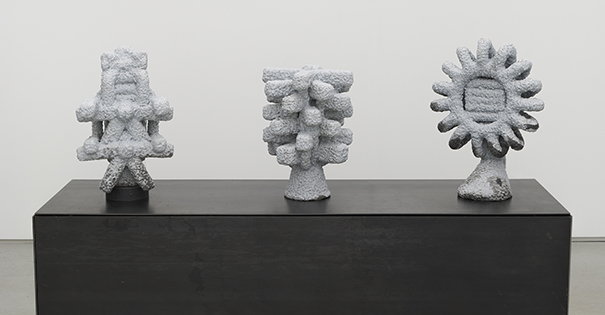
Antonia Kuo (left) Wing Walker, 2022. Ceramic, 23 x 14 x 14 inches. (Center) Turbine, 2022. Ceramic, 23 x 13 x 13 inches. (Right) Helios, 2022. Ceramic, 23 x 19 x 13 inches. Photo: Chapter NY.
The fourth group of works in the exhibition were five unique chemical paintings on light-sensitive silver gelatin paper. The press release for the exhibition states, “Kuo uses masking techniques to manipulate photographic imagery and painterly actions on light-sensitive silver gelatin paper, layering and complicating her source material through an iterative process.” I got some further explanation about the artist’s process from the gallerist, but in the end, setting technique aside, I feel the artist succeeded in showing the viewer something they had never seen before.
Persona (2022), one of the smaller of these works, is a picture within a picture. The most immediate surface is peach and a cool black, evocative of shagreen. It is cut like a window mat and frames a second surface, a book-matched abstraction of copper and blue. It provides a visual link back to the felted wool pieces made by Pauline Shaw. A medium-sized picture, Array (2022), feels like a science fiction version, or an early rendering, of the aforementioned sculpture Helios. It is also in peach and black but puddled with bits of gold. Its metal frame has had circles drilled out of it on one side; the surface of the picture was decorated with steel studs. The overall surfaces of these works feel synthetic and flat, but they have liquidy marks and shadows that look like thick paint. They also have the look of giant halftone photocopies but with a grace that can only be achieved by a thoughtful hand. They feel computer generated but truly emotional. They baffle.
The largest of these works, 93 by 81 inches, is aptly enough called Behemoth (diptych) (2022). It is divided between an upper panel and a slightly larger lower panel. The top reads as landscape, like the tops of trees or tall grasses, in blacks and pinks and coppers. The bottom portion reads as interior, like a warehouse, a factory, or maybe a loft. The same pinks, blacks, and coppers are layered with acid greens and blue-greens and vivid yellow. The lower portion employs a compositional trope in which a rectangular field contains a second rectangle about 80 percent the size of the first. The smaller rectangle is not perfectly squared and is placed somewhat off-center within the larger. This feels awkward and jarring, like something a book about composition would tell you never to do. It incites an emotion. This same compositional technique is found in two other works in this set. It is a bold move to do something that feels so wrong, but it works, and it is thrilling and a little funny.
_1%20front%20rgb.jpg?crc=419469306) According to the gallery’s press release, Shaw is “a first generation Taiwanese American…[who] attempts to reconcile the fragments of her personal memory by supplementing them with imagery borrowed from scientific, cultural, and natural histories.” Also, we’re told that she uses imagery “derived from textiles found in various institutional collections, Chinese paper cutting, and patterns from other craft-based techniques, such as lace and marble-making.”
According to the gallery’s press release, Shaw is “a first generation Taiwanese American…[who] attempts to reconcile the fragments of her personal memory by supplementing them with imagery borrowed from scientific, cultural, and natural histories.” Also, we’re told that she uses imagery “derived from textiles found in various institutional collections, Chinese paper cutting, and patterns from other craft-based techniques, such as lace and marble-making.”
Kuo, we learn, grew up “mixed race and queer to a Buddhist mother and atheist, ex-Roman Catholic priest turned psychoanalyst father [who] encouraged Kuo to eschew definitive categories in her work and in herself.” In that work, she references “industrial materials and machine parts from a metal casting foundry operated by her [family].”
You see the fingerprints and handwriting of these histories throughout the work, especially in the use of materials and the care put into the crafting of the objects. But if you did not read the press release, that is fine. The work in the show is filled with technique, ideas, and beauty, so much so that the viewer would have more than enough to consider.
Paul Moreno is an artist, designer and writer working in Brooklyn, New York. He is a founder and organizer of the New York Queer Zine Fair. His work can be found on Instagram @bathedinafterthought.
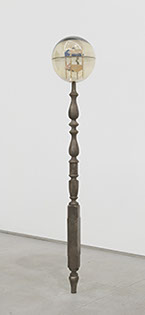
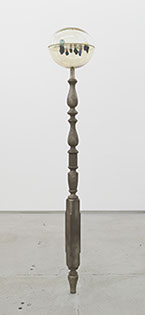
Pauline Shaw (Left), Streetlight, 2022. Handblown glass, marbles, lava rock on cast bronze post, 69 ¼ x 12 x 12 inches. (Right) Nightlight, 2022. Handblown glass, carved basswood, cloth, silver, stone, wool on cast bronze post,
69 ¼ x 12 x 12 inches. Photos: Chapter NY.

Antonia Kuo, Dowager, 2022. Ceramic, wood, 42 x 15 x 15 inches. Photo: Chapter NY.
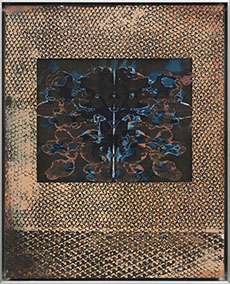
Antonia Kuo, Persona, 2022. Unique chemical painting on light-sensitive silver gelatin paper mounted on aluminum in welded aluminum frame, 21 x 16 ¾ x 1 ½ inches (framed). Photo: Chapter NY.
Antonia Kuo, Behemoth (diptych), 2022. Unique chemical painting on light-sensitive silver gelatin paper on wood panel in welded aluminum frame, 93 x 81 x 2 inches (framed). Photo: Chapter NY.